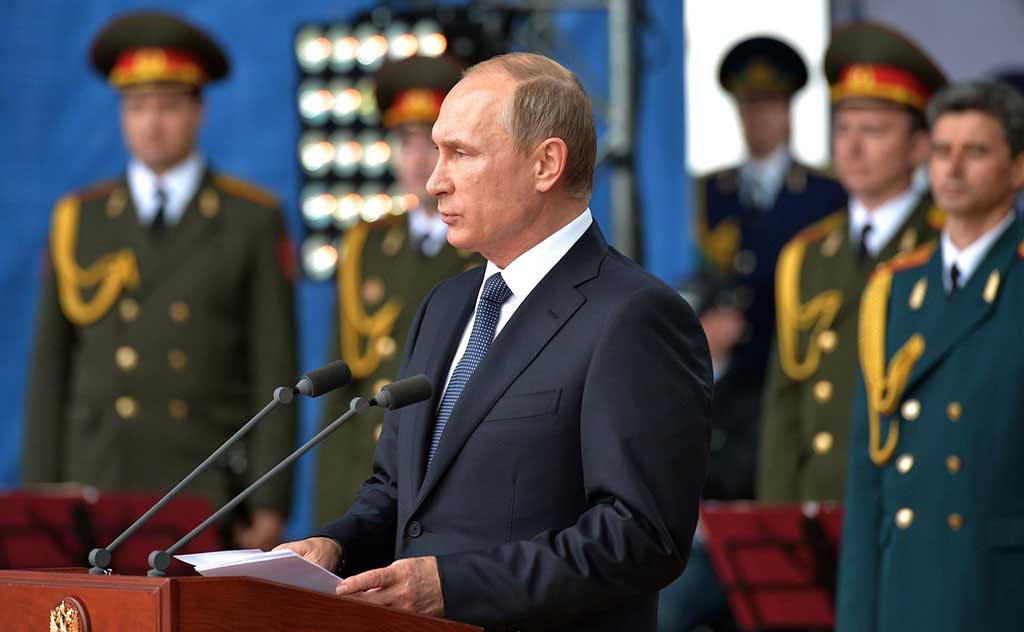2000-
After a Yeltsin’s decade of instability his successor Vladimir Putin was initially well received. Putin then firmly re-centralized the state and renewed the Cold War opposition with the west.

Vladimir Putin At the Military-Technical Forum “Army 2015”, 16 June 2015, Photo by Presidential Press Office
Background
In eight years Yeltsin was not able to solve the problems of economy, corruption and disorder.
Prime Minister
In August 1999, Yeltsin introduced the new prime minister that nobody knew. Less than four weeks later Putin’s effective measures in dealing with the apartment bombings, brought him fame. He then successfully used the Chechen War (1999-2000) in favour of his presidential campaign and easily won the elections.
Presidency
Putin’s reign is characterized by the KGB methods of dealing with opposition and his striving for the grandeur of the Soviet Union.
He imposed firm central control over districts, impeached Yeltsin’s oligarchs, used force to eliminate opposition and induced censorship. Several critics of the Kremlin have died violently.
After his second term, in 2008 Putin had to step down from the presidency. He appointed the yes-man Dmitry Medvedev as president and survived the global recession as a prime minister criticizing the new president. In 2012 they exchanged places again.
Foreign policy
Russia’s has used means of exerting economical and political pressure on its neighbours. Putin’s main goal is to block the influence of NATO and expand the Eurasian Union. Since the Russo-Georgian War (2008), Putin has used military intervention to serve his purpose.
In 2014 Putin launched an extensive hostile campaign against the West, attacking Ukraine in February 2014 and occupying Crimea in March 2014.
Russia Under Putin
2000-
After a Yeltsin’s decade of instability his successor Vladimir Putin was initially well received. Putin then firmly re-centralized the state and renewed the Cold War opposition with the west.
Vladimir Putin At the Military-Technical Forum “Army 2015”, 16 June 2015, Photo by Presidential Press Office
Background
In eight years Yeltsin was not able to solve the problems of economy, corruption and disorder.
Prime Minister
In August 1999, Yeltsin introduced the new prime minister that nobody knew. Less than four weeks later Putin’s effective measures in dealing with the apartment bombings, brought him fame. He then successfully used the Chechen War (1999-2000) in favour of his presidential campaign and easily won the elections.
Presidency
Putin’s reign is characterized by the KGB methods of dealing with opposition and his striving for the grandeur of the Soviet Union.
He imposed firm central control over districts, impeached Yeltsin’s oligarchs, used force to eliminate opposition and induced censorship. Several critics of the Kremlin have died violently.
After his second term, in 2008 Putin had to step down from the presidency. He appointed the yes-man Dmitry Medvedev as president and survived the global recession as a prime minister criticizing the new president. In 2012 they exchanged places again.
Foreign policy
Russia’s has used means of exerting economical and political pressure on its neighbours. Putin’s main goal is to block the influence of NATO and expand the Eurasian Union. Since the Russo-Georgian War (2008), Putin has used military intervention to serve his purpose.
In 2014 Putin launched an extensive hostile campaign against the West, attacking Ukraine in February 2014 and occupying Crimea in March 2014.
Vladimir Putin